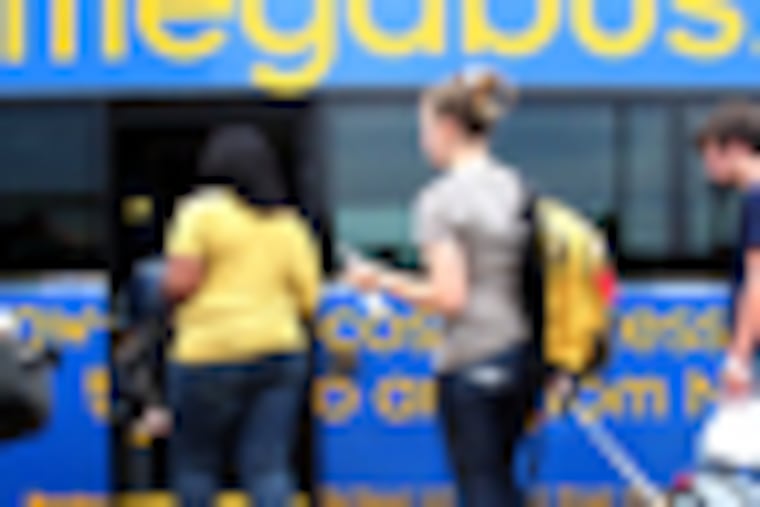Small bus lines merging into the passing lane
Jake Blumgart is a freelance reporter-researcher based in Philadelphia On Halloween weekend, while the Northeast suffered under an unseasonable snowstorm, I stood in line outside 30th Street Station, waiting for the Megabus to New York City. (Ticket: $8.) After the wind yanked my umbrella inside out and the snowflakes began dampening my hair, I decided to distract myself by joining my companions in a chorus of solidarity whining.

Jake Blumgart
is a freelance reporter-researcher based in Philadelphia
On Halloween weekend, while the Northeast suffered under an unseasonable snowstorm, I stood in line outside 30th Street Station, waiting for the Megabus to New York City. (Ticket: $8.) After the wind yanked my umbrella inside out and the snowflakes began dampening my hair, I decided to distract myself by joining my companions in a chorus of solidarity whining.
But for all the expressions of discontent (the bus was late, due to the snow), no one said: "I should have driven." The crowd, mostly young, with some middle-aged types mixed in, weighed the merits of the Greyhound, BoltBus, and Megabus lines, but no one, even in that horrific storm, declared his or her disdain for bus travel. We all packed in when our coach arrived, filling almost every seat.
The fact that Megabus, a curbside operator that provides no shelter for waiting customers, did so well, even on that frigid day, goes to show: Bus travel is bouncing back from its decades-long slump. No matter the weather, or time of day, there are almost always staggeringly long lines of people waiting for a cheap, express trip on BoltBus or Megabus, two of the largest curbside express bus operators to New York, Boston, Washington, and points beyond.
"In 2008, we saw gas over $4 a gallon in some parts of the country and we were going into a recession, high unemployment, and economic uncertainty, and that had an impact on how we traveled," says Dale Moser, president of Coach USA and Megabus.com (the former is the parent company of the latter). "We think we've had a fairly significant influence in getting people out of their cars."
The numbers support Moser's assertion. A 2010 report from DePaul University in Chicago (where Megabus made its U.S. debut) reports: "For the third year in a row, intercity bus service was the fastest-growing mode of intercity transportation, outpacing air and rail transportation." The researchers found that daily bus operations in 2010 increased by 6 percent, down slightly from almost 10 percent growth in 2008. Airline departures for 2010 were up 3 percent, while Amtrak saw growth of just half a percent that year.
The vast majority of that increase is in the curbside-bus sector. Though the data are inexact, DePaul researchers believe "a conservative middle-ground estimate" is that the curbside carriers grew by 33 percent in 2010, while conventional lines like Greyhound and Trailways barely expanded at all.
Despite these promising data, the curbside industry is dogged by safety scandals.
A study in October by the National Transportation Safety Board found that, between 2005 and early 2011, curbside companies had a fatal accident rate of 1.4 per 100 vehicles, compared with 0.2 for conventional bus lines. (Both are still safer than car travel.)
But these findings downplay the massive differences between small, often cut-rate operators and large, highly capitalized companies such as Megabus and BoltBus that can afford to train drivers and maintain safer fleets. The NTSB study shows that it is "motorcoach carriers with 10 or fewer motorcoaches . . . [that] have higher accident rates." When it comes to safe inner-city bus travel, bigger really is better.
"If you don't have adequate capital to buy a decent fleet of buses and maintain them, then the odds are that you are running an unsafe bus," says Larry Hanley, president of the Amalgamated Transit Union. "Greyhound and Bolt are two examples that have the economy of scale to afford real, serious transit managers, drug-testing programs, real training programs, and effective supervision."
Smaller operators' employees are almost never unionized, so they can't bargain for health coverage, better training, or sane working hours. (A report by the ATU shows that many small operators pay so little that their drivers are compelled to work dangerously long hours, even up to 100 hours a week.) Companies like Greyhound have excellent safety records, as does its curbside subsidiary, BoltBus (both are union). Megabus has invested $180 million in its buses, pays its drivers competitively, provides seat belts (which are not required by federal regulations), and, according to Moser, mandates more time off between shifts than the standard Department of Transportation requirement. It also provides buses driven between midnight and 5 a.m. with two drivers, as a safety precaution.
Joseph P. Schwieterman, the DePaul professor behind the bus studies, worries that failing to differentiate between the safety records of name brands and shadowy operators could hurt the industry.
"I'm fearful of an overreaction, as has occurred with high-speed-rail regulation, which resulted in equipment requirements that are punishingly difficult to meet," Schwieterman said.
But despite being tarred by the same brush as the rogue operators, Megabus, and companies like it, continues to expand. On Oct. 25, it opened a hub in Atlanta, servicing 11 cities in the Southeast. When I checked the prices from Atlanta to Charlotte, N.C., a week in advance, the tickets were less than $10 round-trip. Looks as if Southerners have a cheaper and safer way to get to Grandma's house for Thanksgiving. And they won't have to worry about waiting in the snow.